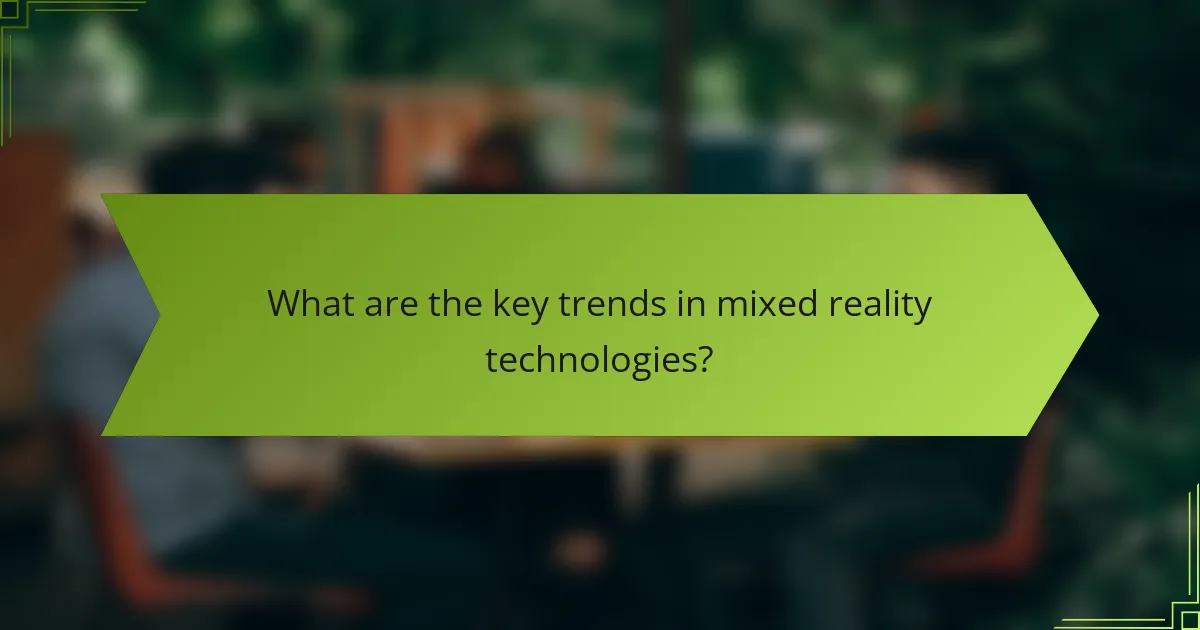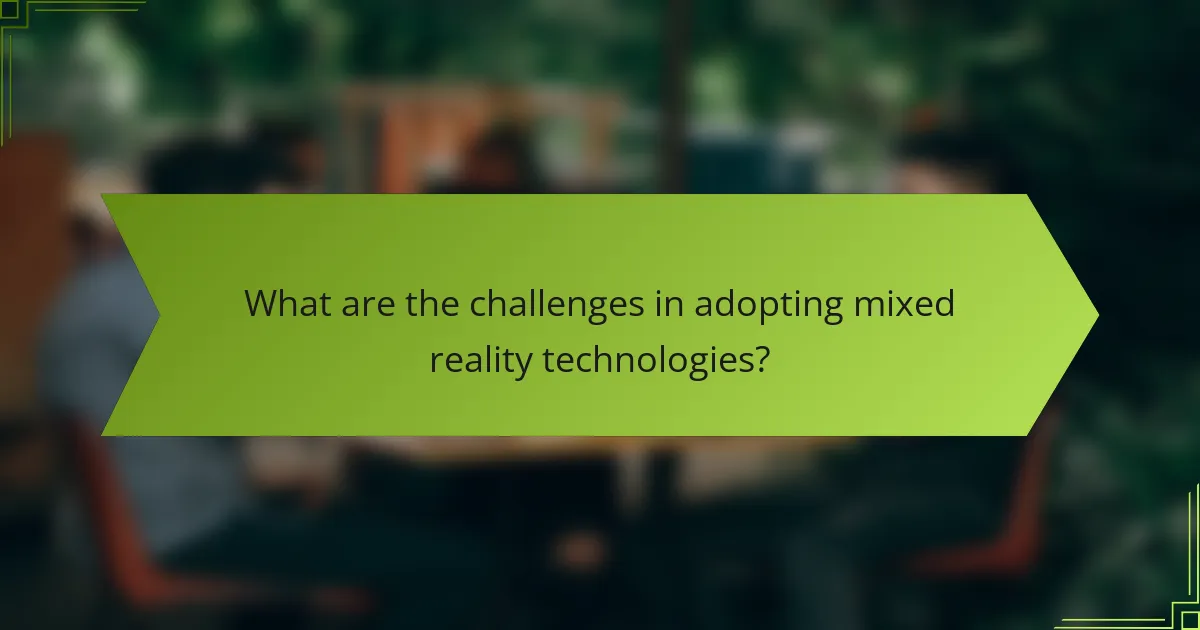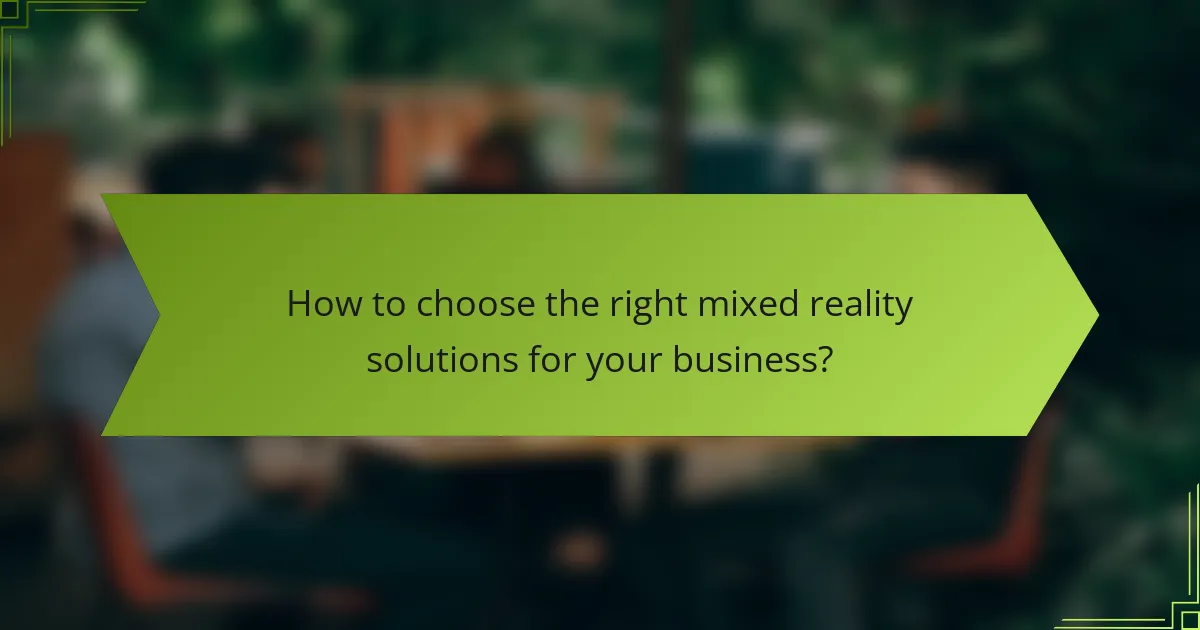The future of mixed reality (MR) technologies is poised for transformative growth, driven by key trends such as artificial intelligence integration, advanced hardware, and cloud-based solutions. These innovations are not only reshaping user interactions with digital content but also enhancing immersive experiences across various industries. As businesses increasingly adopt MR to improve operations and customer engagement, the potential for creating dynamic, interactive environments continues to expand.

What are the key trends in mixed reality technologies?
Key trends in mixed reality technologies include the integration of artificial intelligence, advancements in hardware, and the growth of cloud-based solutions. These developments are reshaping how users interact with digital content and enhancing immersive experiences across various sectors.
Increased integration of AI in mixed reality
The integration of artificial intelligence in mixed reality is transforming user interactions and content generation. AI algorithms can analyze user behavior, personalize experiences, and enhance object recognition, making environments more responsive and intuitive.
For example, AI-driven applications can adapt virtual elements based on real-world conditions, allowing for seamless blending of digital and physical spaces. This capability is particularly useful in fields like education and training, where tailored experiences can significantly improve learning outcomes.
Advancements in hardware for immersive experiences
Recent advancements in hardware are crucial for delivering high-quality mixed reality experiences. Devices such as headsets and smart glasses are becoming lighter, more comfortable, and equipped with higher resolution displays, which enhance visual fidelity and reduce motion sickness.
Additionally, improvements in sensors and tracking technologies enable more accurate spatial mapping and user interaction. For instance, devices now often include hand-tracking capabilities, allowing users to interact with virtual objects naturally, enhancing the overall immersion.
Growth of cloud-based mixed reality solutions
The growth of cloud-based mixed reality solutions is making these technologies more accessible and scalable. By leveraging cloud computing, companies can store and process large amounts of data, enabling real-time rendering of complex environments without the need for powerful local hardware.
This trend allows for collaborative experiences where multiple users can interact within the same virtual space, regardless of their physical location. Industries such as architecture and remote assistance benefit significantly from this capability, as teams can visualize and manipulate 3D models together in real time.

How are businesses leveraging mixed reality?
Businesses are increasingly adopting mixed reality (MR) to enhance operations, improve customer experiences, and streamline training processes. By integrating digital content with the physical world, companies can create immersive environments that drive engagement and efficiency.
Enhanced training and simulation applications
Mixed reality is transforming training and simulation by providing realistic, hands-on experiences without the risks associated with real-world scenarios. Industries such as healthcare, aviation, and manufacturing utilize MR for simulations that allow employees to practice skills in a safe environment.
For instance, medical professionals can use MR to simulate surgeries, enabling them to refine their techniques before working on actual patients. This approach not only reduces training time but also enhances retention of complex procedures.
Improved customer engagement through virtual experiences
Businesses leverage mixed reality to create engaging virtual experiences that captivate customers and enhance brand loyalty. Retailers, for example, use MR to allow customers to visualize products in their own spaces before making a purchase, improving decision-making and satisfaction.
In the real estate sector, MR enables potential buyers to take virtual tours of properties, providing a more immersive experience than traditional photos or videos. This technology can significantly increase interest and reduce the time properties spend on the market.

What innovations are shaping the future of mixed reality?
Innovations in mixed reality (MR) are primarily driven by advancements in hardware and software that enhance user experiences and interactivity. Key developments include augmented reality (AR) glasses and virtual reality (VR) platforms, which are pushing the boundaries of how users engage with digital content in real-world environments.
Development of AR glasses like Microsoft HoloLens 2
The Microsoft HoloLens 2 represents a significant leap in AR technology, offering a more immersive experience with improved comfort and usability. It features advanced sensors and displays that allow users to interact with holograms seamlessly integrated into their physical surroundings.
Key considerations when adopting AR glasses include their application in various sectors such as healthcare, education, and manufacturing. For instance, in healthcare, HoloLens 2 can assist surgeons by overlaying critical information during procedures, enhancing precision and efficiency.
Emergence of VR platforms such as Meta Quest Pro
The Meta Quest Pro is at the forefront of VR technology, providing users with a high-fidelity immersive experience. This platform supports a wide range of applications, from gaming to professional training, making it versatile for different user needs.
When considering VR platforms, factors such as resolution, field of view, and tracking capabilities are crucial. The Meta Quest Pro, for example, offers a resolution that enhances visual clarity, which is essential for prolonged use in training simulations or virtual meetings.

What impacts do mixed reality technologies have on industries?
Mixed reality technologies significantly enhance various industries by merging the physical and digital worlds, leading to improved efficiency, engagement, and innovation. They enable businesses to streamline processes, enhance customer experiences, and develop new solutions tailored to specific needs.
Transforming healthcare through virtual surgeries
Mixed reality is revolutionizing healthcare by allowing surgeons to perform virtual surgeries with enhanced precision. Surgeons can visualize complex anatomical structures in 3D, improving their understanding and execution during actual procedures.
For instance, using augmented reality (AR) overlays during surgery can guide doctors through intricate operations, reducing the risk of errors. Training programs utilizing mixed reality can also simulate real-life scenarios, preparing medical professionals for various challenges they may face in the operating room.
Revolutionizing retail with virtual try-ons
In the retail sector, mixed reality technologies enable customers to virtually try on products, such as clothing or accessories, before making a purchase. This immersive experience not only enhances customer satisfaction but also reduces return rates, benefiting retailers financially.
For example, many fashion brands now offer AR applications that allow users to see how garments fit on their bodies using their smartphones. This technology can be particularly effective in e-commerce, where physical interaction with products is limited, providing a more engaging shopping experience.

What are the challenges in adopting mixed reality technologies?
Adopting mixed reality technologies presents several challenges, primarily high implementation costs and a lack of standardized protocols. These barriers can hinder widespread adoption and limit the potential benefits of mixed reality across various industries.
High costs of implementation
The high costs associated with implementing mixed reality technologies can be a significant barrier for many organizations. Initial investments often include hardware, software, and training, which can range from thousands to millions of dollars depending on the scale and complexity of the project.
Organizations must also consider ongoing expenses such as maintenance, updates, and potential scalability needs. It’s essential to conduct a thorough cost-benefit analysis to determine if the long-term advantages justify the upfront investment.
Lack of standardized protocols
The absence of standardized protocols in mixed reality can lead to compatibility issues and fragmented experiences. Different devices and platforms may not work seamlessly together, complicating integration into existing systems.
To navigate this challenge, businesses should prioritize solutions that adhere to widely accepted standards or are designed for interoperability. Engaging with industry groups focused on developing these standards can also help organizations stay informed and prepared for future advancements.

How to choose the right mixed reality solutions for your business?
Choosing the right mixed reality solutions involves understanding your specific business needs and evaluating potential vendors. Focus on how these technologies can enhance productivity, training, or customer engagement while ensuring compatibility with your existing systems.
Assessing business needs and objectives
Start by identifying the key challenges your business faces and how mixed reality can address them. Consider objectives such as improving training efficiency, enhancing customer experiences, or streamlining operations. This clarity will guide your decision-making process.
Engage stakeholders across departments to gather insights on their requirements. For instance, a retail business might prioritize customer interaction features, while a manufacturing firm may focus on training and maintenance support. Document these needs to create a clear roadmap for evaluation.
Evaluating vendor capabilities and support
When assessing vendors, look for those with a proven track record in delivering mixed reality solutions relevant to your industry. Review their case studies and client testimonials to gauge their effectiveness and reliability. Consider their technology stack and how it integrates with your existing systems.
Support is crucial; ensure the vendor offers comprehensive training, ongoing technical assistance, and updates. A vendor that provides robust support can significantly reduce downtime and enhance user adoption. Ask about their service level agreements (SLAs) to understand response times and support availability.
